During the 2009 and 2010 excavation seasons at Göbekli Tepe, several new trenches at the northwestern hilltop of the tell were opened. Below the plough horizon, as we already had expected, soon rectangular rooms appeared, the characteristic features of the younger Layer II at Göbekli Tepe. However, in the eastern part of the new trenches, the rooms ended quite abruptly. Instead of them, for some time, there was – more or less nothing. That is, of course we were not digging in sterile soil, the sediments were full of finds, just the architecture was missing.

Göbekli Tepe, the areas on the northwestern hilltop under excavation in 2010 (Photo O. Dietrich).
What do you do as an archaeologist in such a situation? Dig on, of course. And after some days of rather monotonous work, that simple strategy paid off. The colour of the sediment suddenly changed into a reddish tone. At Göbekli Tepe, this is a clear indication that you have reached the filling sediments of the older building layer III. And, just to confirm the rule, soon the head of a new monumental pillar appeared.
- Small beginnings – a worked stone, but what will it be? (Photo O. Dietrich).
- After some more days of excavation, the head of a new monumental pillar emerges (Photo Oliver Dietrich).
Unfortunately we were not able to resume work in those areas on the northwestern hilltop in the following years, as other excavation areas and preparation for the construction of permanent shelter structures over the site required the full attention of the excavation team. However, besides new information on the layer II architecture of the side, two important discoveries came from our work in the ‘north-west’.

Göbekli Tepe. A monumental porthole stone from the northwestern hilltop areas (Photo O. Dietrich).
First, a very important detail for the interpretation of the site in general: it seems, that the situation in the main excavation area in the southeastern depression of the tell is not unique. There, the layer II buildings largely exclude the area of the monumental enclosures. This seems to have been a deliberate choice, as a roughly semi-circular ‘terrace wall’ physically marked the position of the Enclosures A-D, giving the tell an amphitheare-like appearance.
Second, in one of the areas, a very important find was made. What seemed in the moment of discovery to be a larger worked stone, a usual thing at Göbekli Tepe, turned after several days of detailed excavation into a monumental porthole stone. Several such stones with a central opening are known from the site, and they could have played a role as entrances to the enclosures or other buildings. One of them lies approximately in the centre of Enclosure B and gives some reason to think about an entrance through a possible roof for that bulding.
- Detail of the sculptures on the monumental porthole stone (Photo O. Dietrich).
However, the new porthole stone from the northwestern areas was completely different, and that not only regarding its enormous measurements of c. 3x3m. First, unlike all examples found before, it has two openings. Second, it is richly decorated with three c. 0.5m long sculptures of quadrupeds (bull, ram and a wildcat) and a 1.5 m long snake in high relief, as well as a row of cupholes. Unfortunately, the stone was not in situ, that is, not in its original architectonic context. But the decorations clearly show that it must have been part of an important building whose entrance had to be guarded accordingly.
Further Reading
Klaus Schmidt, Göbekli Tepe, in: Mehmet Özdoğan – Nezih Başgelen – Peter Kuniholm (Hrsg.), The Neolithic in Turkey. New Excavations & New Research. The Euphrates Basin, Archaeology and Art Publications (2011): 50-52.
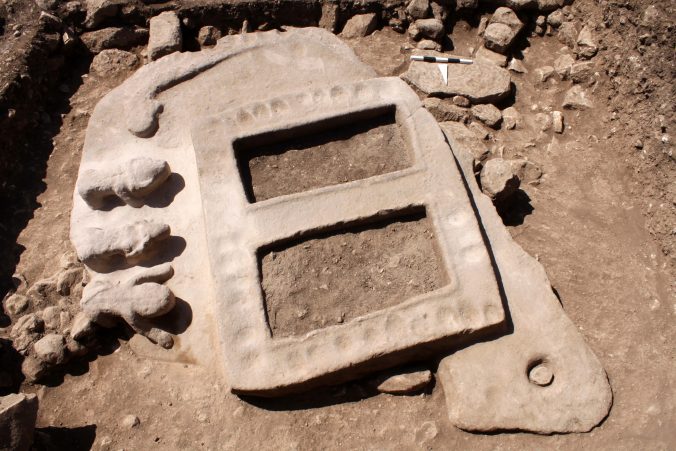
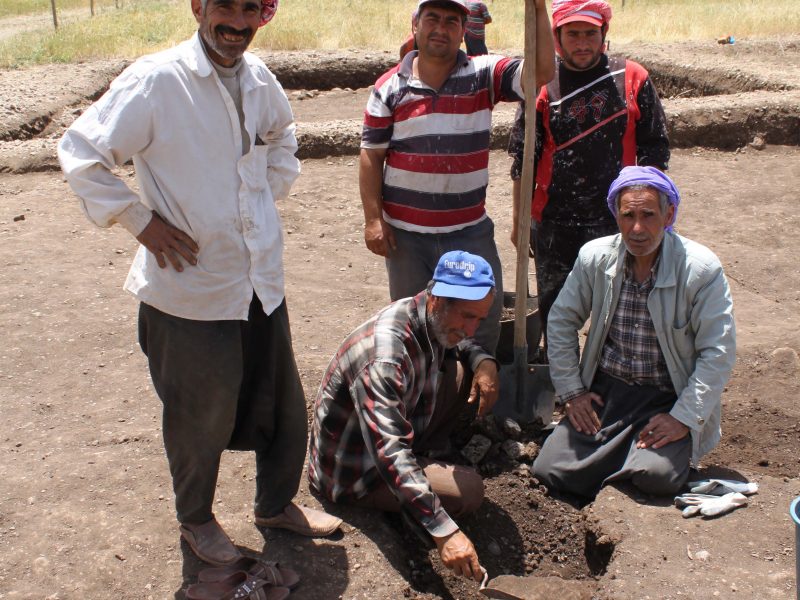
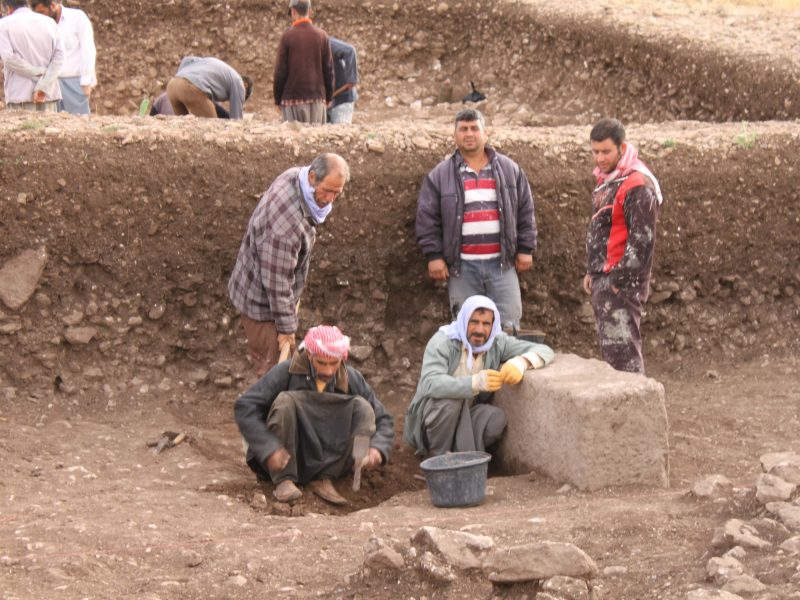
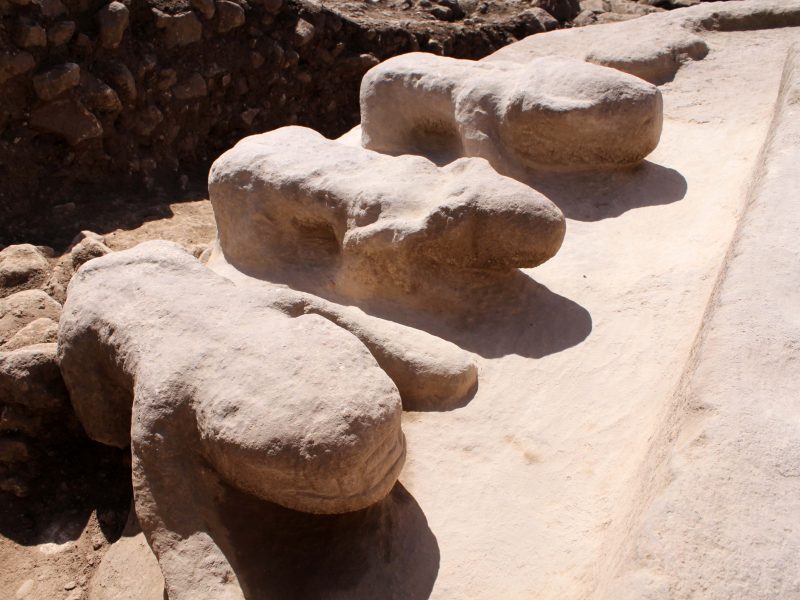
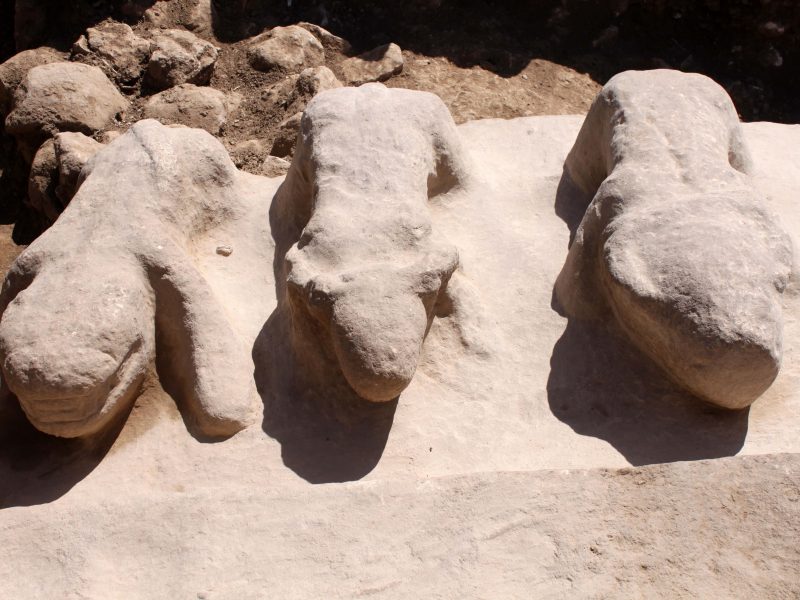
Artisans. Truly beautiful craftsmanship
Is there any evidence of the type of stone used for tools in the masonry process? Local?
Mainly flint, all local. Some groundstone, partly non-local. Obsidian, completely non-local, is severely underrepresented at the site.
And the masonry/pillar rock is sandstone? Any experimental trials been done on the use of the flint? Must have been a risky procedure, given flint’s tendency to splinter?
Limestone. A colleague has done experiments in a limestone quarry in Germany, it worked quite well. I’ll let you know Ehen the results are published.
See also here for details on the process: http://wp.me/p7osoR-5B
May I suggest a hypothesis? As agriculture was being discovered, so was all of the technologies in the new food chain. This porthole could represent a granary. Strong walls that protect cereal for later use, with two section for different crops. The beast would not guard the porthole, rather they roam around with envy. But they are kept at bay and thus, the crops are safe, the granary works.
Interesting idea. But there is no evidence for domestic buildings though so far in GT’s layer III. Secure evidence for agriculture of domesticates dates around 8200 BC, GT’s layer III is c. 9600-8800 BC. Predomestication cultivation may have already been practised in the region though, and large-scale gathering of wild cereals can be assumed .
But if they were hunter-gatherers, would they have ever gathered enough to fill such voluminous spaces and hunt as well?
As I said, there is no evidence for domestic architecture so far in Layer III, so I doubt it was the entrance to a silo. Large-scale gathering and even surplus accumulation are definitely possible for hunter-gatherers.
Seeing the porthole stones at Gobekli Tepe took my mind back to Maltese temples which also have portholes. I think that the portholes were built into structures by Shamin to intimidate whoever entered the building. Some of the shapes of the temple buildings on Malta have similarity to Gobekli Tepe.
My research is into Who built the Brochs and this too has many questions and no answers. I live on the Isle of Skye where I am surrounded by Brochs and some Brochs have small entrances but the are for defence as far as I can tell.
I am amazed at the length of time Gobekli Tepe has been built and rebuilt but not many artefacts have been found for the length of occupation. I have also found that artefacts are very scarce in the Brochs.
Thanks for your comment. One short remark: we really have a lot of artifacts from GT.